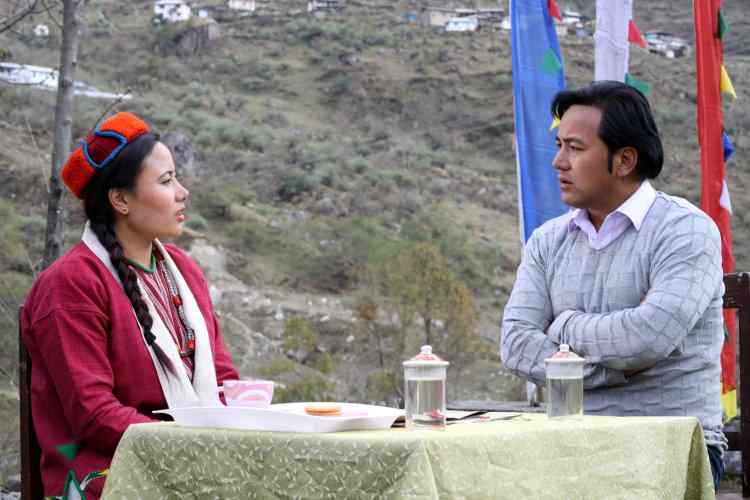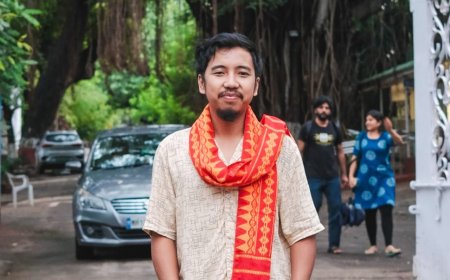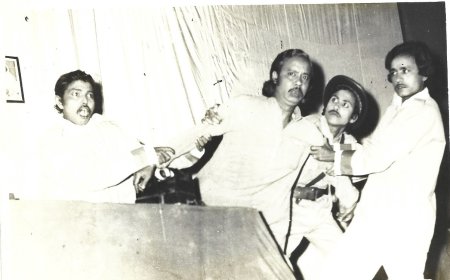Film review: Manju Borah's film , In the land of Poison women
'The most challenging and toughest terrain for Manju and her team was coursing through the rough terrain and trying to acclimatise with the virulent climate to shoot the film.', writes Shoma A.Chatterji

Manju Borah would have not needed an introduction had she not been making her films in Assam and other lesser explored cultural spaces in the North East because her films mainly remain confined to film festivals in India and abroad. But most of them have bagged National Awards in more than one category. Her first feature film Baibhab (A Scam in Verse), released in 1999, was bestowed on the Jury’s ‘Special Mention’ at the 47th National Film Festival, 2000 and named the Best Film in Asia at the 6th Dhaka International Film Festival, 2000. She was also the recipient of the Gollapudi Srinivas Award for Best Debut Director in 1999. But these are only the tip of an iceberg of awards that came her way over time. She has been bestowed the Women of Excellence Award by FICCI for her outstanding contribution to the Film & Entrepreneurship in 2009 and the Satyajit Ray Memorial Award by the Asian Film Foundation in 2012.She is also credited with having made Sarbagunakar Srimanta Sankardeva, the first animated feature film in the history of cinema in the North East which was a great commercial success in Assam.
“My mission, though I am not a sloganeering kind of filmmaker, is to try and explore the culture of the different segments of Assam and try to present its impact on the person and society as a whole. I do not really do all this consciously but this feel towards humane subjects and issues works at a subconscious level in my choice of subjects, stories and so on,” she says.
Since then, she has come a long, long way and every single film of hers is unique in terms of its subject matter, mainly an exploration of small ethnic groups, their language, culture, philosophy and lifestyle and most importantly, their impoverished lifestyle sometimes resulting from poverty, sometimes the consequence of ethnic resurgences and often, due to outdated social norms.
Her seventh film Ko-Yad (Whirlpool) was screened at the 19th Kolkata Film Festival, the MAMI Film Festival, the Leh International Film Festival. Ko-Yad won two National Awards– for Best Cinematography and for the Best Film in the Mising language. Ko-Yad, Manju says, “is based on a novel originally written in Assamese but against the backdrop of the Mising community who speak the Mising language. The Misings are the second largest ethnic group in the North East with a demographic spread of 25 lakh people. They do not have a script so I had to work out a script in Assamese written phonetically to fit into the Mising language. Interestingly, I do not know a word of Mising so that was another challenge.”
Explaining what pulled her to the story, Manju says, “It is based on a philosophy which states that ‘nothing is permanent.’ It is the story of a man who realizes that people he felt he was very close to left him. Even the boat he stuck to risking his relationships with everyone else, is sucked in the river by a whirlpool. His wife, however, remained with him like a pillar of support though he failed to appreciate and understand her value in his life.”
Aesthetically too, in terms of the harmonizing and synchronizing the techniques of cinema to make a visually beautiful film has become a signature for Manju. She mostly works with non-actors in little known languages and not known to the rest of India. “For Ko-Yad, I did not take professional actors because firstly, I did not want to impose their screen images on my characters. Secondly, I wished to bring the film as close to reality as possible and these people were natural. We held a six-week-long acting workshop with the local cast and shot the entire film in this Mising village at a single stretch for 22 days. The Disang River which forms a strong part of the narrative features in the film not only as a physical reality but also as a metaphor for life."
The most challenging film in her entire career spanning 23 years is perhaps In the Land of Poison Women made in 2018. It is based on a story by Yeshe Dorje Thongchi. He is a prolific writer of Assam. Sahitya Akademi Award winner Sri Thongchi from the Sherdukpan community of Arunachal Pradesh writes in Assamese. His works reflect the socio-political and cultural structure of Arunachal Pradesh where a huge number of ethnic groups live. “All his writings are based on true stories drawn from his work as a civil services officer posted at various places in the state, during which Sri Thongchi had the opportunity to come close to different communities and drew from his interactions with them,” Manju adds.
“The unknown community shown in the film is known as Pangchenpa and their place of living in the remote corner of the country, with less than 5000 population. This was one of the main reasons I chose this novel. The location was a point of both attraction and challenge. Pangchen or Zemithang is situated along the Indo-China international border and very sensitive and high alert zone. Secondly, the story about Pangchenpa women was the biggest challenge. They are believed to be Poison Women who carry poison on their nails. The legend goes that whoever takes food cooked and served by them, die either instantly or slowly but most certainly, die. Can you even believe that such a belief exists in this country?” she asks. “The women themselves believe this and are unwilling to think and do otherwise,” adds Manju.
The protagonist of In the Land of Poison Women is an educated Pangchenpa girl who, an administrative officer herself, marries the newly appointed SIB (Subsidiary Intelligence Bureau) officer and the two together try their best to eradicate this belief through various educational programmes in the villages of the area. But does she succeed? She is also efficient in her other duties too. “I wanted to show that even a girl from the Pangchenpa community can become the role model of an ideal, committed and efficient officer for the rest of the country,” Manju elaborates.

Image: film still
The most challenging and toughest terrain for Manju and her team was coursing through the rough terrain and trying to acclimatise with the virulent climate to shoot the film. “The place we first visited was so mesmerising that I wanted to shoot everywhere! But our area of work was confined within a 10/15 kms radius. The place is called Zemithang that stands by the river Namyangchu flowing down from China. The main problem was that the places we chose to shoot were motorable, but the villages were as if hanging in the hills. So, we had to climb down everywhere, sometimes one km or more along the uneven narrow paths and climb up again to reach our vehicles parked on the roads. Walking on those uneven roads was really difficult specially at night after finishing our work, when we were too tired. I had to take help from my boys lest I fall down or slip on the slippery paths!”
“The climate was extremely harsh. Though the shooting was in the valley, the breeze in the afternoons would bring the temperature down to 0 degrees Celsius and when we reached the point of shooting, it would come down to -8 degrees Celsius. The valley is surrounded by thick layers of snow. We would sometimes feel like leaving the shoot and scoot. But our passion and dedication drove us to go on. I would feel really bad for the spot boys, production boys, light boys and kitchen staff who had to carry the heavy equipment and foodstuff up and down for one full month in that harsh climate and atmosphere. But we did it and came back unharmed,” laughs Manju.
For this film, it was difficult for Manju to arrange a proper workshop because of time constraints and the distance of the location from Guwahati. “But with the help of the local assistants, I somehow managed to handle my entire cast of non-actors and the result is excellent though time-consuming. It was more difficult because some of my actors could neither read nor write and managed to memorise the long dialogue just by listening to the language assistant.”
Manju feels working with non-actors is better for her kind of films than professional actors. They are so natural both in dialogue delivery and in body language that they actually “become” the characters and when one is watching the film, one feels as though one is entering into the story instead of just watching the film.
While shooting in a particular village Manju and her crew were surprised to encounter an old woman known as a ‘domoh’ (Poison woman) who lived in an isolated house all by herself. “I was already warned by my local coordinator not to accept any food from any woman. But when we were shooting in a house close to where the woman lived, I just could not resist a momo-like food item. She initially refused, but, on my insistence, she obliged and made a delicious dip of homemade cheese and garlic chilli paste. I was scolded later by my local assistants!”
“Through the film In the Land of Poison Women I have tried to contrast the status of two different women from two different backgrounds. One is labelled a Poison Woman and forced to live an isolated life rejected by society carrying the guilt of having killed her two children including few of their friends after having served them wine she had brewed herself that turned out to be poisonous. The other woman is an educated, smart and confident government officer who tries to remove the age-old superstition that believes that women carry poison in their nails. I have tried to spread this message among small ethnic groups that with education and determination, their women can also go up in life like any city woman and help their weaker peers in uplifting their lives,” she sums up.
***
About the author: Dr. Shoma A. Chatterji is an Indian film scholar and author based in Kolkata.
What's Your Reaction?



































































